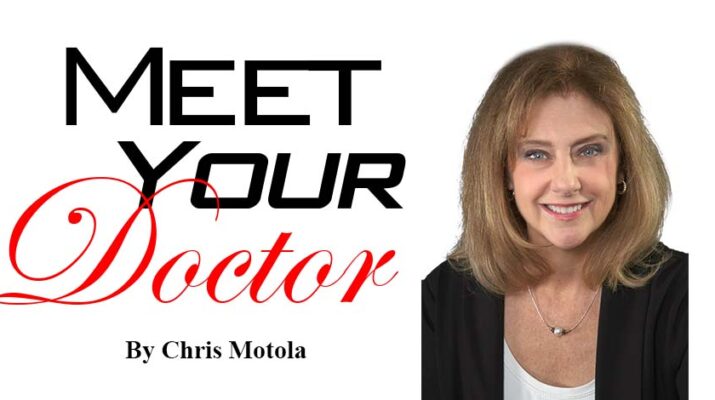President of Monroe County Medical Society working toward reducing burnout among local physicians. “We’re trying to make real attempts to combat it.”
By Chris Motola
Q: What’s it been like running the Monroe County Medical Society the past year or so?
A: I became president last spring, in June. And of course, there’s been the challenge of COVID-19 for the last year, last two years. We haven’t been able to get together in person for most of our events, which is a bit of a disappointment since we’re a collegiate society. But we’ve managed. We’ve had a lot of initiatives this past year, and we’ve tried to move the society forward despite the tough times. But yeah, it’s been a little bit of a challenge.
Q: What kinds of initiatives have you been working on?
A: Over the last few years we’ve had a couple of new committees, the most recent of which is timely given that it’s something everyone is dealing with right now with COVID-19. We started a wellness committee. I think, in every profession right now, that stress has had an effect on people. We’ve had the Great Resignation in the last year with people either leaving jobs or changing jobs. It’s really no different in medicine. And we know that, even before COVID-19 hit, we’ve had a lot of burnout and stress in medicine. So we’re trying to make real attempts to combat it.
Q: How complicated is the burnout issue?
A: It’s not just small things, but getting at systemic issues, the real roots of the problems that create burnout to begin with, and then recent stressors on top of that. Maybe we should have started it a little bit earlier, but we’ve finally gotten ourselves organized, so we’re happy about that. We also have a very robust diversity and equity inclusion committee, which we hadn’t had before. We started that in 2021, and it’s already led to some effective changes in how we do testing, which means it’s a pretty big success.
Q: What is the quality collaborative?
A: We’ve also worked on a committee that we call “quality collaborative.” It’s a multidisciplinary committee where people who are experts in their fields can come up with community standards. That’s been very busy this year. And we do support our private practices and their offices. That’s been very busy since those practices have needed support for vaccines, testing. And finally, I think something Monroe County Medical Society does really well is advocacy with the state medical society, and advocating for our patients.
Q: What are the factors, other than COVID-19, leading to burnout?
A: One of the big factors is filling out paperwork for insurance companies. Regulation and preauthorization for everyday testing creates a lot of hoops for physicians to jump through while we’re trying to take care of patients. And then there are regulatory issues from Albany. Scope of practice issues, limitations on what we’re able to do in this state and in this part of the country. And just the everyday workflow. The electronic health record is not fast to work with. It takes physician-patient face-to-face encounters and changes them in a way that’s been tough on docs and a lot of patients. It’s increased patient dissatisfaction, which we in turn have to deal with. So those are big three, and then you put COVID on top of that. It has led to a lot of illness, patient confusion about policy and erratic availability of elective procedures. It’s stretched staff thin.
Q: You mentioned taking a more equity-based approach to testing. What does that look like in practice?
A: Kidney function testing—estimated glomerular filtration rate (eGFR)—which is a way we measure kidney function and kidney failure, and is used for many tests, particularly in radiology. So eGFR has used a formula that includes race for absolutely no good reason. So when you’re entering a patient, you’d fill in a form with a drop-down menu that included things like age, and race was also on it. It was never scientifically based and led to inconsistent results that negatively affect minority populations because disease wasn’t being picked up at a stage where it could be easily treated. So as of March 1, throughout the system, we removed the race classification for eGFR throughout our system. So through our committee we were able to quickly get something done that has positive, measurable results and benefits all patients.
Q: As far as the lobbying activities go. Given the regulations against collective bargaining for doctors, how hard is it to get Albany or Washington to respond to physician issues?
A: We have a lobbying day, March 8, where groups of physicians from across the state get together for a morning of education, dealing with legislative folks from the state and then in the afternoon dealing with our local legislative folks to address issues. So that’s a thing we do once a year, but we’re constantly in contact with our local legislators and people with influence in Albany to try to advocate for our doctors. And through our doctors, advocating for our patients. We look at the governor’s budget, which includes medicine, and try to identify the good things in it. There are also always some challenging things. So we’ll give positive feedback for the good stuff and then work to try to get the things that aren’t in the patient’s best interests changed. That’s part of what we do every year.
Lifelines
Name: Susan A. Danahy, M.D. FACR
Position: Diagnostic radiologist at Borg and Ide Imaging, LLC (since 2001); president of Monroe County Medical Society, since June 2021
Hometown: Buffalo
Education: University at Buffalo School of Medicine and Dentistry; Syracuse University
Affiliations: Strong Memorial, Unity Hospital, Rochester Regional
Organizations: American College of Radiology; New York State Radiological Society; Monroe County Medical Society
Family: Two sons, one grandchild
Hobbies: Tennis, skiing

